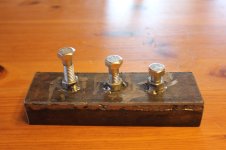OP
joshuabardwell
Elite Member
I got the nuts welded on.

I used a combination of the tips presented here. Using the bolt to hold the nut in place while welding was genius. Not sure why I didn't think of that to begin with. I built a small puddle on the base metal and then tried to draw it over to the nut. In the past, when I've done this, I've had problems with wiping the weld metal up the face of the nut, but not heating the nut enough to get it to penetrate, but it worked okay this time. All three nuts are secure and the bolts turn freely. Up next: paint.

I used a combination of the tips presented here. Using the bolt to hold the nut in place while welding was genius. Not sure why I didn't think of that to begin with. I built a small puddle on the base metal and then tried to draw it over to the nut. In the past, when I've done this, I've had problems with wiping the weld metal up the face of the nut, but not heating the nut enough to get it to penetrate, but it worked okay this time. All three nuts are secure and the bolts turn freely. Up next: paint.